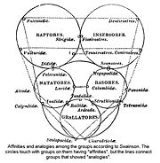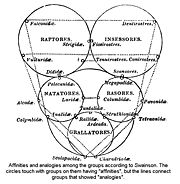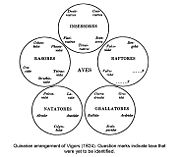
Quinarian system
Encyclopedia
The Quinarian system was a method of zoological classification which had a brief period of popularity in the mid 19th century, especially among British naturalists. It was largely developed by the entomologist W. S. MacLeay
in 1819. The system was followed by Nicholas Aylward Vigors
and William John Swainson. Swainson's work on ornithology gave wide publicity to the idea.
 Quinarianism gets its name from the emphasis on the number five: it proposed that all taxa are divisible into five subgroups, and if less than five subgroups were known, quinarians believed that a missing subgroup remained to be found.
Quinarianism gets its name from the emphasis on the number five: it proposed that all taxa are divisible into five subgroups, and if less than five subgroups were known, quinarians believed that a missing subgroup remained to be found.
 Presumably this arose as a chance observation of some accidental analogies between different groups, but it was erected into a guiding principle by the quinarians. It became increasingly elaborate, proposing that each group of five classes could be arranged in a circle, with those closer together having greater affinities. Typically they were depicted with relatively advanced groups at the top, and degenerate forms towards the bottom. Each circle could touch or overlap with adjacent circles (a phenomenon called 'osculation').
Presumably this arose as a chance observation of some accidental analogies between different groups, but it was erected into a guiding principle by the quinarians. It became increasingly elaborate, proposing that each group of five classes could be arranged in a circle, with those closer together having greater affinities. Typically they were depicted with relatively advanced groups at the top, and degenerate forms towards the bottom. Each circle could touch or overlap with adjacent circles (a phenomenon called 'osculation').
 Another aspect of the system was the identification of analogies across groups:
Another aspect of the system was the identification of analogies across groups:
Quinarianism was not widely popular outside the United Kingdom; it had become more or less unfashionable by the 1840s, during which time more complex "maps" were made by Hugh Edwin Strickland
and Alfred Russel Wallace
. Strickland and others specifically rejected the concept of "analogy". These systems were eventually discarded in favour of principles of classification based on evolutionary relationship.
William Sharp MacLeay
William Sharp Macleay was a British civil servant and entomologist.-Early life:Macleay was born in London, eldest son of Alexander Macleay who named him for his then business partner, fellow wine merchant William Sharp. He attended Westminster School and Trinity College, Cambridge graduating with...
in 1819. The system was followed by Nicholas Aylward Vigors
Nicholas Aylward Vigors
Nicholas Aylward Vigors was an Irish zoologist and politician.Vigors was born at Old Leighlin, County Carlow. He studied at Trinity College, Oxford. He served in the army during the Peninsular War from 1809 to 1811. He then returned to Oxford, graduating with a B.A. in 1815 and in 1817 with an...
and William John Swainson. Swainson's work on ornithology gave wide publicity to the idea.



Quinarianism was not widely popular outside the United Kingdom; it had become more or less unfashionable by the 1840s, during which time more complex "maps" were made by Hugh Edwin Strickland
Hugh Edwin Strickland
Hugh Edwin Strickland , was an English geologist, ornithologist,naturalist, and systematist.Strickland was born at Reighton, in the East Riding of Yorkshire. He was the second son of Henry Eustatius Strickland of Apperley, Gloucestershire, by his wife Mary, daughter of Edmund Cartwright, D.D. [q...
and Alfred Russel Wallace
Alfred Russel Wallace
Alfred Russel Wallace, OM, FRS was a British naturalist, explorer, geographer, anthropologist and biologist...
. Strickland and others specifically rejected the concept of "analogy". These systems were eventually discarded in favour of principles of classification based on evolutionary relationship.

